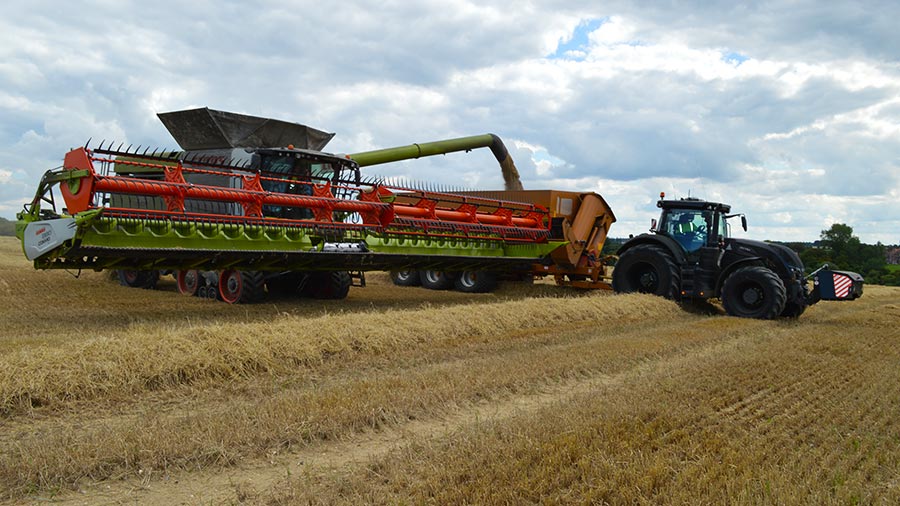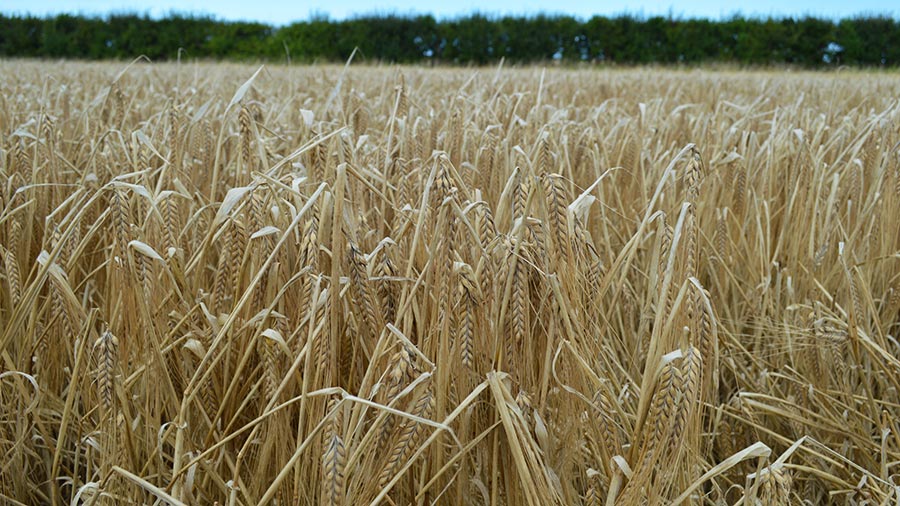Harvest 2023: Early spring malting barley crops show promising quality
 Norfolk barley harvest © MAG/David Jones
Norfolk barley harvest © MAG/David Jones Spring malting barley crops are showing promising grain quality from the early harvested areas across south and eastern England, although yields are a touch disappointing after such a difficult growing season.
Maltsters are cautious on the overall outlook, with much of the important Scottish spring malting crop still to cut in rainy harvesting weather. But English malting crops are generally of good low grain nitrogen content and low screenings.
In the light lands of north Norfolk, one of the heartlands of English malting barley growing, harvest is virtually complete with most grain hitting distilling quality of less than 1.65% nitrogen grain content.
See also: Wheat yields good but doubts on quality for 2023 harvest
Early drilled crops
James Beamish, farm manager at Holkham Estate, has finished cutting 350ha of the popular variety Laureate at just under his five-year average yield of 6.5t/ha, with February sown crops all at less than 1.65% nitrogen.
“The February drilled crops showed excellent quality and average yields, while later drilled crops showed a decline in quality and quantity,” he says from the estate which farms 4,000ha of land in-house.
A lot of the early drilled crops showed nitrogen levels down at 1.3% and 1.4%, but poor weather delayed the drilling of a relatively small area of ground until early April. This crop produced higher nitrogen of 1.8-1.9%, he adds.
Mike Wilton, farm manager at Stody Estate, reported a similar picture with all his 140ha of Laureate hitting his five-year average yield of 6.5t/ha, and all grain cut under 1.65% nitrogen.
“The crop recovered well after a cold and wet spring to produce very average yields, but the quality was good,” he says.
The area of spring barley was down on the 1,680ha estate as more winter wheat was drilled in the open autumn last year.
Bit disappointing
Another farm manager on a nearby estate says his malting barley quality has been good, but yields were only average to a bit disappointing after crops were hit by poor weather.
He grew 300ha of Laureate which yielded right on the farm’s five-year average of 6.5t/ha, with grain nitrogen content below 1.65%.
The highest nitrogen across all spring and winter barleys was 1.55%.
“The yield turned out to be average but was a little disappointing after the crops established so well, but then they were hit by dull and cold weather in May and very hot conditions in June,” he says.
Winter malting barleys saw a similar picture with 80ha of specialist old variety Maris Otter yielding down 5% on the five-year average at 5.3t/ha, rather than 5.5-6t/ha as expected.
Meanwhile, 220ha of the newer variety Electrum yielded at the five-average at 7.5t/ha, both with low nitrogen levels.
Maltsters’ needs
The maltsters are likely to buy 1.9-2m tonnes of malting barley from the 2023 UK harvested crop – this is out of a total barley crop, which at the UK 2022 harvest was nearly 7.4m tonnes.
Dual-purpose spring varieties such as Laureate, Diablo, Sassy and Firefoxx can be used for distilling and brewing, while Planet and the winter malting types tend to be used for brewing.
In England, the variety Laureate is the most popular accounting for about 40% of purchases by maltsters, followed by Planet and then winter variety Craft.
In Scotland, Laureate is even more dominant, accounting for two-thirds of purchases followed by Diablo and Sassy.
Many growers and maltsters have growing concerns about the over-reliance on Laureate. Although it is an excellent variety, they say it would be good to have more diversity in varieties to help with the security of supply.
Distillers, who account for 55% of UK malting barley demand, generally look for barley with grain nitrogen of less than 1.65%, while brewers who account for just over 30% of demand look for under 1.85%.
The rest of the crop is used in food manufacturing or exported.
The maltsters point out that early English malting samples are looking promising, but can be quite variable due to the difference in sowing dates.
Later sown crops are showing poorer quality, while the very early crops from Scotland look quite variable in quality.

Laureate spring barley in Norfolk © MAG/David Jones
Low nitrogen levels
Mark Ineson, grain supply chain manager at maltster Muntons, says barley coming into his group’s maltings at Bridlington in east Yorkshire is showing good low nitrogen levels.
The group has a second maltings at Stowmarket in Suffolk.
“For the spring barley crops we have seen so far, the majority are under 1.65% nitrogen, with most in the 1.6% area,” he says.
Harvest is well under way in Yorkshire, and 75% of the malt output from the Bridlington plant goes for distilling and the rest to brewing. Mark says he is seeing variable quality in the Scottish crop as harvest there just starts.
Jonathan Arnold, trading director at Hampshire-based grain merchant Robin Appel, says he is delighted with the quality of the spring barley crops, with not a lot of grain over 1.65% nitrogen.
He has also seen good yields from early drilled crops on the chalklands of southern England.
“Yields have been fairly good and quality has been excellent. We are very pleased with the spring barley crop in the main,” he says.
Jonathan points out that the leading variety Laureate has performed well as it is a more dormant variety than most others, and it is less likely to sprout in the ear.
Therefore, it is better able to withstand quite of a lot of moisture, even when it is fit to harvest.
He sees malting premiums over feed barley holding at £65-£80/t for good quality crops cut in southern and eastern England, and is helped by concerns over crops elsewhere.
Jonathan believes the Scottish spring malting barley harvest will not produce a “vintage crop” due to late drillings, a very dry June and then wet into the harvest.
Meanwhile, Danish malting crops look to be producing some high nitrogen levels.

